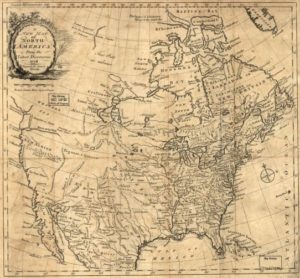Events
 The Spanish were the first Europeans to settle in North America. A map of mid 18th century North America shows the sweeping expanse of this empire, from the fortress of San Augustín, Florida — the first continuous European settlement in North America founded in 1565 predating Jamestown, Virginia — to the small outpost of San Francisco started in the desolate wilderness of Alta California in 1776. Spanish explorers traveled further north along the Pacific Coast to Canada in 1774 and by the late 1700s had established a military post on Vancouver Island, 350 miles north of Seattle. The Spanish sailed from the Caribbean to the Chesapeake Bay in 1526, then called the Bahía de Santa María, about 80 years before the romanticized English encounter with Pocahontas. In the 1520’s Spanish navigators also explored as far north as Cape Cod, Massachusetts, and the present site of Bangor, Maine.
The Spanish were the first Europeans to settle in North America. A map of mid 18th century North America shows the sweeping expanse of this empire, from the fortress of San Augustín, Florida — the first continuous European settlement in North America founded in 1565 predating Jamestown, Virginia — to the small outpost of San Francisco started in the desolate wilderness of Alta California in 1776. Spanish explorers traveled further north along the Pacific Coast to Canada in 1774 and by the late 1700s had established a military post on Vancouver Island, 350 miles north of Seattle. The Spanish sailed from the Caribbean to the Chesapeake Bay in 1526, then called the Bahía de Santa María, about 80 years before the romanticized English encounter with Pocahontas. In the 1520’s Spanish navigators also explored as far north as Cape Cod, Massachusetts, and the present site of Bangor, Maine.
This historic presence is reflected in a number of the key events in the American Revolution in which the Spanish and Hispanic Americans participated. Spanish merchants followed their long-established trade lines from Bilbao in northern Spain to ship supplies for the war to the New England ports. General Charles Lee of the Continental Army sent soldiers to New Orleans in 1776 to request military supplies from the Spanish, which were given to the American Cause. To raise money for their declared war against the British that began in 1779, King Carlos III levied a specific tax paid by Spanish and Hispanic Americans in California and New Mexico. That year, Bernardo de Galvez launched his sweeping attack on British forces from Mobile, Alabama to Pensacola, Florida. Finally, the Spanish and Latinx funded the last major battle of the American Revolutionary War, at the Battle of Yorktown in 1781.
